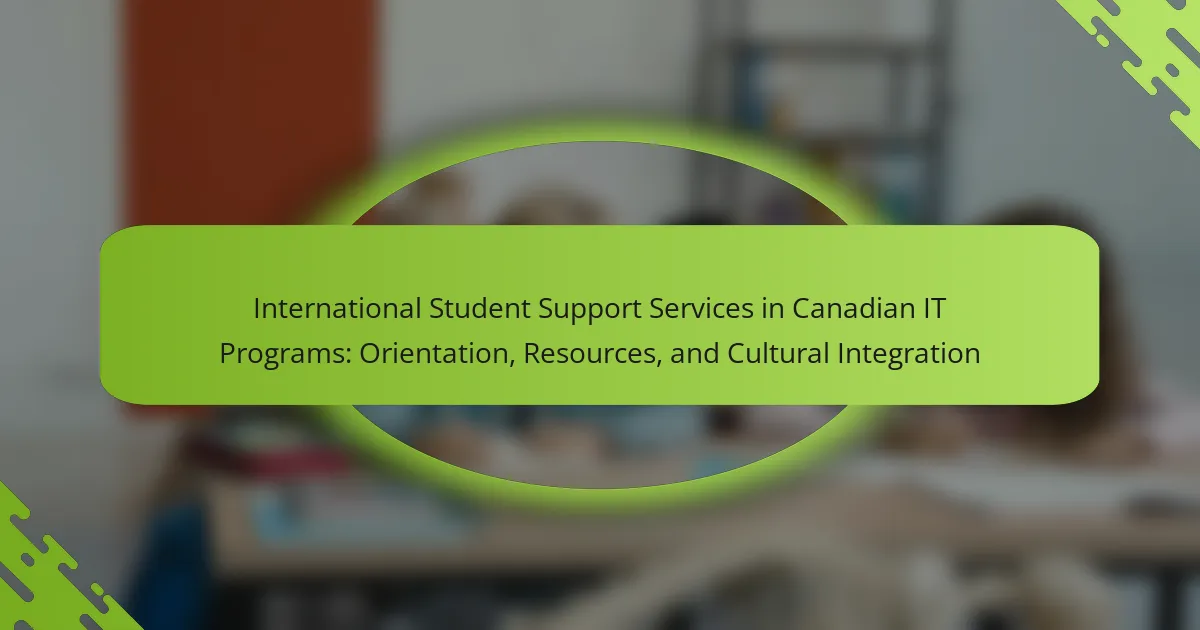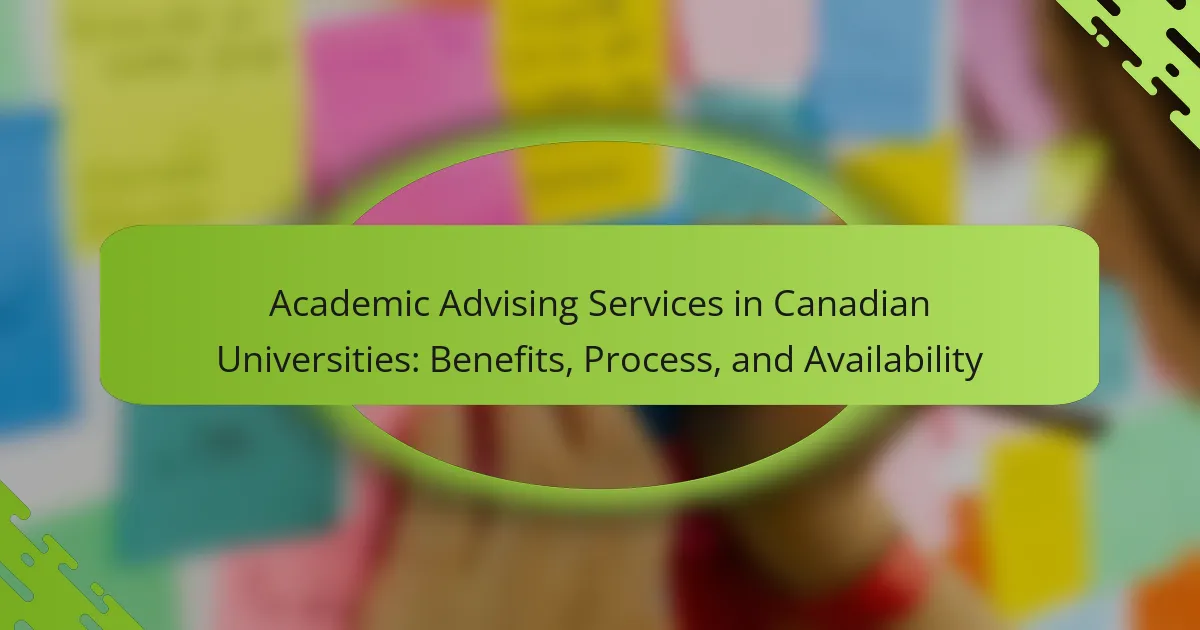Financial aid options for IT students in Canada encompass scholarships, grants, and loans, aimed at alleviating the financial burden of education in technology-related fields. Scholarships are awarded based on academic merit or specific criteria, while grants are need-based and do not require repayment. Government programs, including Canada Student Grants, and internal scholarships from institutions provide additional support. Despite the availability of these resources, students often face challenges such as incomplete applications, lack of awareness, and strict eligibility criteria, which can hinder their ability to secure funding. Current trends indicate an increasing demand for tech skills and a shift toward online education, prompting governments and institutions to enhance financial aid offerings for IT programs.

What are the Financial Aid Options for IT Students in Canada?
Financial aid options for IT students in Canada include scholarships, grants, and loans. Scholarships are awarded based on academic merit or specific criteria. Grants are typically need-based and do not require repayment. Government programs, such as the Canada Student Grants, provide financial support for eligible students. Institutions also offer internal scholarships and bursaries. Additionally, students can apply for provincial financial aid programs. Federal student loans are available to help cover tuition and living expenses. Each option has specific eligibility requirements and application processes.
How do Scholarships fit into Financial Aid for IT Students?
Scholarships are a vital component of financial aid for IT students. They provide financial support that does not require repayment. Scholarships can cover tuition fees, books, and other educational expenses. Many scholarships are merit-based, rewarding academic achievement or skills in IT. Other scholarships may be need-based, targeting students with financial difficulties. In Canada, various organizations and institutions offer scholarships specifically for IT students. These scholarships can significantly reduce the financial burden of pursuing a degree in information technology. According to the Canadian Scholarship Trust Foundation, scholarships help increase access to education for underrepresented groups in IT. Overall, scholarships enhance the financial aid landscape for IT students, making education more accessible and affordable.
What types of Scholarships are available for IT Students?
Merit-based scholarships are available for IT students. These scholarships reward academic excellence and high GPA. Need-based scholarships assist students with financial challenges. Some scholarships target specific demographics, such as women in technology. Industry-sponsored scholarships offer funding from tech companies. Scholarships may also be offered by universities to attract talent. Professional organizations provide scholarships to promote diversity in IT fields. Government grants may also support IT education.
What are the eligibility criteria for IT Scholarships?
Eligibility criteria for IT scholarships typically include academic performance, enrollment in an IT program, and residency status. Many scholarships require a minimum GPA, often around 3.0 on a 4.0 scale. Applicants usually need to be enrolled in a recognized institution offering IT courses. Some scholarships may also be limited to Canadian residents or citizens. Specific scholarships may require demonstrated financial need or involvement in extracurricular activities related to technology. It’s essential to check individual scholarship requirements for additional criteria.
What role do Grants play in Financial Aid for IT Students?
Grants provide essential financial support for IT students, covering tuition and educational expenses. They do not require repayment, making them a favorable option for students. In Canada, various grants are available specifically for IT programs. These grants can significantly reduce the financial burden on students. For instance, the Canada Student Grant for Full-Time Students offers up to $6,000 annually. Additionally, provincial grants may further enhance financial aid opportunities. Grants help promote access to education by supporting students from diverse backgrounds. This financial assistance encourages more individuals to pursue careers in information technology.
What types of Grants can IT Students apply for?
IT students can apply for several types of grants. These include federal grants, provincial grants, and institutional grants. Federal grants are provided by the Canadian government, such as the Canada Student Grant for Full-Time Students. Provincial grants vary by region, such as the Ontario Student Grant. Institutional grants are offered by specific colleges or universities to support their students. Many of these grants do not require repayment, making them an attractive option for funding education.
How do Grants differ from Scholarships for IT Students?
Grants and scholarships are both forms of financial aid for IT students, but they differ in key ways. Grants are typically need-based and do not require repayment. They are often funded by government agencies or institutions. Scholarships, on the other hand, are usually merit-based and awarded for academic achievements or specific talents. Scholarships may require ongoing academic performance to maintain eligibility. According to the Government of Canada, grants are designed to assist students with demonstrated financial need, while scholarships recognize excellence in various fields. Thus, the primary distinction lies in the criteria for awarding and the obligation for repayment.
What is the Application Process for Financial Aid?
The application process for financial aid typically involves several key steps. First, students must complete the Free Application for Federal Student Aid (FAFSA) or the relevant provincial application in Canada. This form gathers financial information to assess eligibility. Next, students should check the specific requirements for scholarships or grants they are interested in. Each program may have different criteria and deadlines. After submitting the application, students may need to provide additional documentation, such as tax returns or proof of income. Finally, students will receive a financial aid offer detailing the types and amounts of aid they qualify for. This process is essential for securing funding for education.
What steps are involved in applying for Scholarships?
The steps involved in applying for scholarships include researching available scholarships, gathering required documents, completing the application form, writing a personal statement, obtaining letters of recommendation, and submitting the application before the deadline. Researching scholarships helps identify suitable opportunities based on eligibility criteria. Required documents often include transcripts and proof of enrollment. The application form must be filled out accurately with personal and academic information. A personal statement should reflect the applicant’s goals and achievements. Letters of recommendation provide insights into the applicant’s character and abilities. Finally, submitting the application on time is crucial for consideration.
What documentation is required for Grant applications?
Grant applications typically require several key documents. Commonly required documentation includes a completed application form. Applicants must also submit a project proposal outlining objectives and methods. Financial statements are often necessary to demonstrate need. Letters of support or recommendation may strengthen the application. A detailed budget plan is usually required, showing how funds will be allocated. Additionally, proof of eligibility, such as academic transcripts, may be needed. These documents ensure that the application meets the grant’s criteria and supports the evaluation process.
How can IT Students maximize their Financial Aid opportunities?
IT students can maximize their financial aid opportunities by actively researching and applying for scholarships and grants. They should regularly check their institution’s financial aid office for updates on available funding. Engaging with online databases and scholarship search engines can reveal additional opportunities. IT students must maintain a strong academic record, as many scholarships require a minimum GPA. They should also participate in extracurricular activities related to their field, as this can enhance their applications. Networking with faculty and industry professionals can provide insights into lesser-known funding sources. Completing the Free Application for Federal Student Aid (FAFSA) accurately and on time is essential for accessing federal aid. Additionally, students should consider local community organizations that offer scholarships specifically for IT students.
What tips can help improve Scholarship application success?
To improve scholarship application success, applicants should focus on several key strategies. First, they must thoroughly research available scholarships. Understanding eligibility criteria and requirements is crucial. Second, applicants should tailor their application materials. Customizing essays and personal statements can make a significant difference. Third, maintaining a strong academic record is essential. Many scholarships prioritize high GPA and relevant coursework. Fourth, gathering strong letters of recommendation is important. Recommendations from teachers or mentors can enhance credibility. Fifth, applicants should meet all deadlines. Timely submissions demonstrate organization and commitment. Finally, practicing for interviews can boost confidence. Many scholarships involve an interview process that assesses fit and motivation. Following these tips can significantly increase the chances of securing a scholarship.
How can students effectively research Grant opportunities?
Students can effectively research grant opportunities by utilizing online databases and resources. Websites like Grants.gov and the Canadian government’s funding portal provide comprehensive listings. Students should also visit their educational institution’s financial aid office for tailored information. Networking with professors and industry professionals can uncover lesser-known grants. Additionally, joining relevant online forums and social media groups can yield valuable insights. Regularly checking for updates on grant availability is crucial. Many grants have specific eligibility requirements, so students must read guidelines carefully. By following these strategies, students can maximize their chances of finding suitable grant opportunities.

What are the Common Challenges in Securing Financial Aid?
Common challenges in securing financial aid include incomplete applications, lack of awareness of available options, and strict eligibility criteria. Incomplete applications can lead to automatic disqualification from funding opportunities. Many students are unaware of scholarships and grants specifically for IT programs. Eligibility criteria often require maintaining a certain GPA or demonstrating financial need. Additionally, competition for limited funds can be intense, making it difficult for applicants to stand out. Misunderstanding the application process can also result in missed deadlines or incorrect submissions. These factors collectively hinder many students from successfully obtaining financial aid.
What obstacles do IT Students face when applying for Financial Aid?
IT students face several obstacles when applying for financial aid. One major challenge is the complexity of the application process. Many students struggle with understanding the required documentation. Additionally, the competitive nature of financial aid can be daunting. Limited funding means that not all applicants receive aid.
Another obstacle is a lack of awareness about available options. Some students may not know about specific scholarships or grants for IT programs. Furthermore, eligibility criteria can be confusing. Students may inadvertently apply for aid they do not qualify for.
Lastly, students often face time constraints. Balancing studies, work, and the application process can be overwhelming. These challenges can hinder their ability to secure necessary financial support for their education.
How can students overcome common application challenges?
Students can overcome common application challenges by thoroughly researching requirements. Understanding scholarship and grant criteria is essential. Organizing application materials in advance helps reduce stress. Seeking guidance from academic advisors can provide clarity. Practicing time management ensures deadlines are met. Utilizing resources like online forums can offer peer support. Additionally, reviewing successful applications can provide insights. Engaging in workshops can enhance application skills.
What resources are available to assist with the application process?
Resources available to assist with the application process include official websites, financial aid offices, and online forums. Official websites provide detailed guidelines and eligibility criteria for scholarships and grants. Financial aid offices at educational institutions offer personalized assistance and advice. Online forums connect students with peers for shared experiences and tips. Additionally, organizations like the Canadian Scholarship Trust Foundation provide resources and support. Government websites also list available financial aid options and application procedures. These resources ensure students have the necessary information to navigate the application process effectively.
What are the best practices for managing Financial Aid?
The best practices for managing financial aid include thorough research, timely applications, and careful documentation. Students should start by understanding the types of financial aid available, including scholarships and grants. They must meet all application deadlines to maximize their funding opportunities. Maintaining accurate records of financial documents is essential. Regularly communicating with financial aid offices can provide updates and resolve issues quickly. Additionally, students should review their financial aid packages to ensure they understand the terms and conditions. Monitoring their academic progress is also crucial, as many aid programs require satisfactory academic performance. Following these practices can significantly enhance the financial aid experience for students.
How can IT Students effectively budget their Financial Aid funds?
IT students can effectively budget their financial aid funds by creating a detailed budget plan. This plan should outline all expected expenses, including tuition, books, and living costs. Students should categorize these expenses into fixed and variable costs. Fixed costs remain constant, while variable costs can fluctuate.
Next, students should track their income from financial aid and any additional sources. This helps in understanding how much money is available for spending. It is crucial to prioritize essential expenses over discretionary spending.
Students should also consider using budgeting tools or apps to monitor their spending. Regularly reviewing their budget allows them to adjust as needed. Research indicates that students who budget effectively are less likely to experience financial stress.
By following these steps, IT students can maximize their financial aid funds and ensure they meet their educational expenses.
What should students know about maintaining eligibility for ongoing aid?
Students must understand specific requirements to maintain eligibility for ongoing financial aid. Most aid programs require students to maintain a minimum GPA, often around 2.0 on a 4.0 scale. Additionally, students must complete a certain number of credit hours each semester, typically at least 12 credits for full-time status. Regularly submitting the Free Application for Federal Student Aid (FAFSA) or provincial equivalents is crucial for continued eligibility. Some scholarships may have specific renewal criteria, such as participation in extracurricular activities or community service. Students should also be aware of any changes in their financial situation, as this may affect their aid status. Staying informed about deadlines and requirements from the financial aid office is essential for ongoing support.

What Future Trends are Influencing Financial Aid for IT Students?
Future trends influencing financial aid for IT students include increased demand for tech skills and the rise of online education. The job market is evolving rapidly due to technological advancements. This has led to a greater focus on STEM education, including IT programs. As a result, governments and institutions are allocating more funds for scholarships and grants in these fields. Additionally, the COVID-19 pandemic accelerated the shift to online learning. This has prompted financial aid programs to adapt by offering more flexible funding options. Data from the Canadian government shows a 15% increase in financial aid applications for IT-related programs over the past year. These trends indicate a growing recognition of the importance of financial support for IT education.
How is the landscape of Financial Aid changing for IT Students?
The landscape of financial aid for IT students is evolving with increased funding opportunities and targeted scholarships. Many institutions are now offering specialized grants to support technology-focused education. This shift addresses the growing demand for skilled IT professionals in the job market. According to a report by the Canadian government, there is a projected shortage of 216,000 tech workers by 2021. Furthermore, private organizations are launching initiatives to provide financial support specifically for underrepresented groups in IT. These changes indicate a proactive approach to ensuring access to education in the technology sector.
What new funding opportunities are emerging for IT education?
New funding opportunities for IT education include government grants, private scholarships, and industry partnerships. The Canadian government has introduced initiatives to support technology training. For example, the Canada Job Grant provides funding for employers to train employees in IT skills. Additionally, organizations like the Canadian Information Processing Society offer scholarships specifically for IT students. Industry partnerships are also emerging, where tech companies fund educational programs to develop a skilled workforce. These funding sources aim to enhance accessibility and support the growing demand for IT professionals.
How are technological advancements impacting Financial Aid processes?
Technological advancements are streamlining Financial Aid processes. Automation reduces paperwork and speeds up application reviews. Online platforms allow students to apply for aid from anywhere. Data analytics improve decision-making for fund allocation. Real-time updates keep students informed about their application status. Mobile apps enhance accessibility to financial resources. Additionally, artificial intelligence assists in personalized financial advising. These advancements lead to a more efficient and user-friendly experience for students seeking financial aid.
What resources can IT Students use to stay informed about Financial Aid?
IT students can use several resources to stay informed about financial aid. University financial aid offices provide personalized assistance and information on available scholarships and grants. Online platforms like ScholarshipsCanada and Yconic offer comprehensive databases of financial aid opportunities. Government websites, including the Canada Student Loans Program, outline federal and provincial aid options. Professional organizations in IT may also offer scholarships and resources for students. Social media groups and forums can provide peer support and updates on financial aid. Regularly checking these resources ensures students remain informed about deadlines and new opportunities.
How can students utilize online platforms for Financial Aid information?
Students can utilize online platforms for Financial Aid information by accessing dedicated websites and resources. Websites such as the Government of Canada’s Student Aid portal provide comprehensive information on grants and scholarships. Online databases like ScholarshipCanada and Yconic offer searchable listings of available funding options. Social media platforms can connect students with peer groups sharing financial aid experiences. Educational institutions also host online resources detailing specific financial aid programs. Many community organizations publish relevant information on their websites. Online forums and discussion boards allow students to ask questions and share insights. Utilizing these platforms helps students stay informed about deadlines and application processes.
What role do educational institutions play in providing Financial Aid resources?
Educational institutions play a crucial role in providing financial aid resources. They serve as intermediaries between students and various funding sources. Institutions often offer scholarships, grants, and work-study programs to support students financially. They also provide guidance on applying for government aid programs and private scholarships. Many institutions have dedicated financial aid offices to assist students with their applications. These offices help students understand eligibility requirements and deadlines. Additionally, schools may offer their own financial literacy programs to educate students about managing aid effectively. This comprehensive support enhances students’ access to necessary financial resources for their education.
Financial Aid Options for IT Students in Canada encompass various forms of financial support, including scholarships, grants, and loans. Scholarships are awarded based on academic merit or specific criteria and do not require repayment, while grants are typically need-based and also do not require repayment. The article details types of scholarships and grants available, eligibility criteria, and the application process for both. Additionally, it addresses common challenges faced by IT students in securing financial aid and offers strategies to maximize funding opportunities. Finally, the article highlights future trends influencing financial aid in the IT sector.



